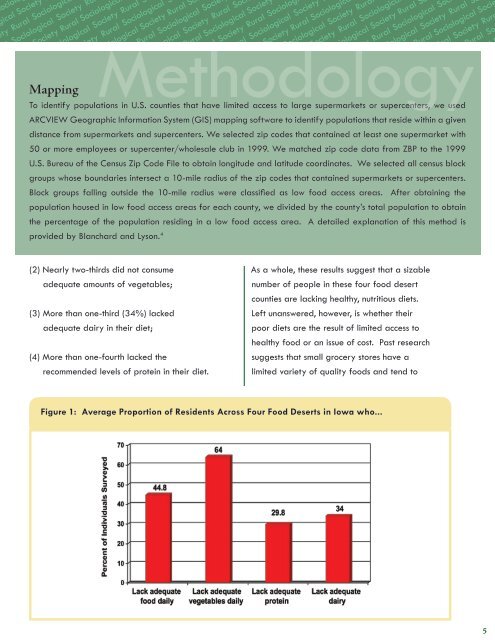Starved for Access: Life in Rural America's Food Deserts
Starved for Access: Life in Rural America's Food Deserts
Starved for Access: Life in Rural America's Food Deserts
Create successful ePaper yourself
Turn your PDF publications into a flip-book with our unique Google optimized e-Paper software.
Methodology<br />
Mapp<strong>in</strong>g<br />
To identify populations <strong>in</strong> U.S. counties that have limited access to large supermarkets or supercenters, we used<br />
ARCVIEW Geographic In<strong>for</strong>mation System (GIS) mapp<strong>in</strong>g software to identify populations that reside with<strong>in</strong> a given<br />
distance from supermarkets and supercenters. We selected zip codes that conta<strong>in</strong>ed at least one supermarket with<br />
50 or more employees or supercenter/wholesale club <strong>in</strong> 1999. We matched zip code data from ZBP to the 1999<br />
U.S. Bureau of the Census Zip Code File to obta<strong>in</strong> longitude and latitude coord<strong>in</strong>ates. We selected all census block<br />
groups whose boundaries <strong>in</strong>tersect a 10-mile radius of the zip codes that conta<strong>in</strong>ed supermarkets or supercenters.<br />
Block groups fall<strong>in</strong>g outside the 10-mile radius were classified as low food access areas. After obta<strong>in</strong><strong>in</strong>g the<br />
population housed <strong>in</strong> low food access areas <strong>for</strong> each county, we divided by the county’s total population to obta<strong>in</strong><br />
the percentage of the population resid<strong>in</strong>g <strong>in</strong> a low food access area. A detailed explanation of this method is<br />
provided by Blanchard and Lyson. 4<br />
ociolog<br />
ical ral SociologicalSocietyRura<br />
iologicalSociety<strong>Rural</strong>Sociological<br />
Society<strong>Rural</strong>SociologicalSociety<strong>Rural</strong>So<br />
y SociologicalSociety<strong>Rural</strong>SociologicalSo<br />
l ical Society<strong>Rural</strong>SociologicalSociety<strong>Rural</strong>SociologicalSociety<br />
ociety<strong>Rural</strong>SociologicalSociety<strong>Rural</strong>SociologicalSociety<strong>Rural</strong>Socio<br />
<strong>Rural</strong>SociologicalSociety<strong>Rural</strong>SociologicalSociety<strong>Rural</strong>SociologicalSociety<br />
ogicalSociety<strong>Rural</strong>SociologicalSociety<strong>Rural</strong>SociologicalSociety<strong>Rural</strong>Sociologic<br />
ral SociologicalSociety<strong>Rural</strong>SociologicalSociety<strong>Rural</strong>SociologicalSociety<strong>Rural</strong>Soc<br />
Society<strong>Rural</strong>SociologicalSociety<strong>Rural</strong>SociologicalSociety<strong>Rural</strong>SociologicalSocie<br />
SociologicalSociety<strong>Rural</strong>SociologicalSociety<strong>Rural</strong>SociologicalSociety<strong>Rural</strong>So<br />
ociety<strong>Rural</strong>SociologicalSociety<strong>Rural</strong>SociologicalSociety<strong>Rural</strong>SociologicalSocie<br />
ologicalSociety<strong>Rural</strong>SociologicalSociety<strong>Rural</strong>SociologicalSocietyRura<br />
logicalSociety<strong>Rural</strong>SociologicalSociety<strong>Rural</strong>Sociological<br />
ociologica<br />
o<br />
y <strong>Rural</strong> SociologicalSociety<strong>Rural</strong>SociologicalSociety<strong>Rural</strong>SociologicalSocietyR<br />
ogicalSociety<strong>Rural</strong>SociologicalSociety<strong>Rural</strong>SociologicalSociety<strong>Rural</strong>Sociological<br />
SociologicalSociety<strong>Rural</strong>SociologicalSociety<strong>Rural</strong>SociologicalSociety<strong>Rural</strong><br />
cal Society<strong>Rural</strong>SociologicalSociety<strong>Rural</strong>SociologicalSociety<strong>Rural</strong>Sociological<br />
(2) Nearly two-thirds did not consume<br />
adequate amounts of vegetables;<br />
(3) More than one-third (34%) lacked<br />
adequate dairy <strong>in</strong> their diet;<br />
(4) More than one-fourth lacked the<br />
recommended levels of prote<strong>in</strong> <strong>in</strong> their diet.<br />
As a whole, these results suggest that a sizable<br />
number of people <strong>in</strong> these four food desert<br />
counties are lack<strong>in</strong>g healthy, nutritious diets.<br />
Left unanswered, however, is whether their<br />
poor diets are the result of limited access to<br />
healthy food or an issue of cost. Past research<br />
suggests that small grocery stores have a<br />
limited variety of quality foods and tend to<br />
<br />
Figure 1: Average Proportion of Residents Across Four <strong>Food</strong> <strong>Deserts</strong> <strong>in</strong> Iowa who...<br />
5
















